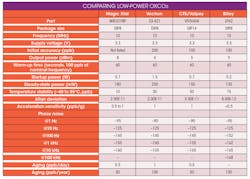LP OCXOs Rise to Meet the Demand for Lower-Power Oscillators
With the growing need for oscillators to have good stability and low-power requirements, several companies in the RF industry are looking for newer technologies to fill this void. Luckily, these technologies are beginning to appear throughout the tech market.
Here, we're talking mainly about low-power oven-controlled frequency oscillators, or more simply, "LP OCXOs." Let's dive deeper into why LP OCXOs are receiving so much attention within the frequency-control and RF world.
TCXOs vs. OCXOs vs. LP OCXOs
TCXOs are commonly used for reference and local-oscillator needs in low-power situations. Unfortunately, they tend to possess only moderate temperature stability, okay short-term stability, and decent phase noise.
OCXOs offer great improvement in these areas, but it comes at a cost, namely power consumption. While TCXOs have a current draw of around 2 to 20 mA, an OCXO normally pulls 150 to 300 mA with a startup or “warming” current of 200 to 600 mA.
The ultimate oscillator would provide OCXO performance for TCXO power budgets. That vision is quickly turning to reality through a new class of OCXOs: low-power OCXOs. These units try to harness the best of both worlds.
Specific Uses for LP OCXOs
Low-power OCXOs can be used in a wide variety of applications. Some great examples include mobile test-equipment devices, medical equipment (including MRI devices), military drones and unmanned aerial vehicles (UAVs), and various transmitters and receivers. Other frequent applications for LP OCXOs include:
- EO small satellites
- Other military devices
- Synthesizers
- System clocks
- Phase-locked loops
Top LP OCXO Manufacturers
The data below paints a picture of the oscillators being produced by several manufacturers, and offers comparisons based on datasheet specifications.
Phase noise: Phase-noise performance is a big factor in many RF designs. Noise is the bane of most applications. All of the units looked at have similar performance, with Bliley’s LP62 holding a slight edge at a few offsets.
Temperature stability: Over a wide range of temperatures, Magic Xtal’s MXO37/8 and MXO37/8P are by far superior. The firm has been in the low-power game the longest, but other manufacturers are starting to catch up. In fact, at narrower temp ranges, the others may be just about as good. This is an important factor when selecting a frequency-control reference. The operational temperature range of the oscillator can have a significant impact on performance and cost.
Allan deviation: If short-term stability is a key factor in your design, then Bliley’s LP62 ranks as the top choice. Its unit specs at 8E-12 while all of the others spec at 20E-12.
Acceleration sensitivity: If your design is going to be used in a fairly static situation, then this isn’t much of a worry. However, if the environment has high acceleration, vibration-induced phase noise may become an issue. Both Magic Xtal’s and Bliley’s oscillators are less sensitive and should give better performance.
Power consumption: This spec represents the main purpose of opting for a LP OCXO: How much power is this performance going to cost? At a steady-state power drain of 135 mW, Bliley’s LP62 has a bit of a lead here. What truly stands out is the startup power. The LP62 only pulls 200 mW, less than 1/3 of the nearest competitor. If you’re concerned with battery life, especially in power-cycling conditions, that’s fantastic.
If you might be considering an LP OCXO for your design, this chart offers a further breakdown of available options:
The Final Call
Above is a summary of the main low-power OCXOs on the market. So, which will work best for you? It simply depends on the critical needs of your design. For a tight temperature stability, Magic Xtal is the winner. For lowest power consumption, particularly at startup, and Allan deviation, the Bliley LP62 comes out on top.


